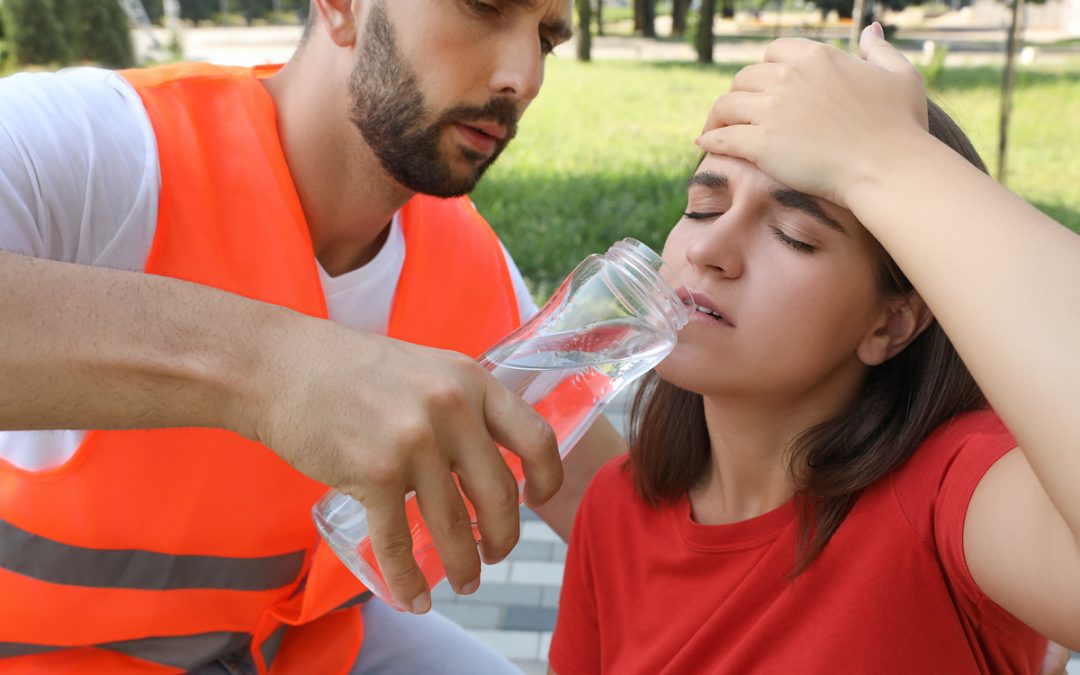eSafety’s Heat-Related Illness series was developed to create a better understanding of the different types of heat-related illnesses. These illnesses are prevalent in the workplace year-round, and can affect anyone working in a warm, humid environment both indoors and outdoors. This series will cover topics that include the different types of heat-related illnesses, signs and symptoms of these illnesses, and workplace prevention methods.
As summer weather continues to heat up, the risk of heat-related illnesses increases. If you are working in hot, humid conditions, it’s always important to:
- Stay hydrated with water and drinks with electrolytes
- Take regular breaks so you don’t become overheated
- Modify work schedules to avoid hot work conditions
- Use the buddy system
- Use personal protective equipment that provides cooling
- Prepare workers’ bodies through acclimatization
Here is a look at the definitions and descriptions of each of the 6 types of heat-related illnesses, so you can learn what signs to look for, and what actions to take in the event that you or a co-worker starts exhibiting symptoms of a heat-related illness.
#1 Heat Rash
Heat rash is the least serious heat-related illness. It’s usually more uncomfortable than it is dangerous. Heat rash appears on the body in small red bumps, usually on the chest and neck, in the groin area, and in the elbow creases. This heat-related illness occurs when sweat is unable to evaporate from the surface of the skin, which can happen when you’ve spent long hours working and sweating in hot conditions.
Heat rash is not a dangerous heat-related illness, but it is a good idea to hydrate and move out of the hot weather if you’re experiencing heat rash symptoms.
To treat heat rash, you can take a cool shower and let your skin air dry. If the area is itchy or irritated, apply a cool compress.
#2 Heat Syncope
Heat syncope is a heat-related illness that results in an individual’s collapse or loss of consciousness due to heat exposure. Unlike other heat-related illnesses, individuals experiencing heat syncope will not experience an increase in body temperature or a cessation of sweating.
If you are exposed to a warm, humid environment and are experiencing light-headedness from standing up quickly, or from prolonged standing, know that these are symptoms of heat syncope. Fainting for short durations and dizziness are also symptoms of heat syncope.
Those experiencing heat syncope or heat syncope symptoms should sit or lie down in a cool area, and slowly drink water or an electrolyte drink.
#3 Heat Cramps
Heat cramps are muscle cramps or spasms that occur when your body lacks both salt and water. It’s possible to experience heat cramps even if you’ve been hydrating, because you may not be replenishing the salt levels in your body that deplete when you sweat.
Heat cramps most commonly occur in the arms, legs, or abdomen. The best way to combat heat cramps is to:
- Move to a cooler place for at least a few hours
- Stop all activity
- Loosen clothing
- Drink 8 ounces of cool water or an electrolyte drink every 15 to 20 minutes
- Apply a cool wet compress to the cramping area
If your cramps do not begin to subside within an hour of these treatments, seek medical attention. If you have heart problems, or on a low-sodium diet, it’s also important to seek medical attention immediately. If not treated immediately, heat cramps can lead to heat exhaustion.
#4 Heat Exhaustion
Of all the heat-related illnesses, heat exhaustion is the most common. It’s also a serious type of heat-related illness that should be addressed as quickly as possible. Heat exhaustion is caused by the body’s extreme depletion of water and salt.
Symptoms of heat exhaustion are often similar to those of the flu — headache, fatigue, dizziness, irritability, thirst, nausea or vomiting — though heat exhaustion symptoms can also include a slightly elevated body temperature, excessive sweating, or a fast heart rate. See Symptoms of Heat Exhaustion and Heat Stroke for more information.
If not treated, this level of dehydration can lead to heat stroke, which is the most serious heat-related illness. If you notice someone experiencing heat exhaustion:
- Move them into a cool, less humid area
- Have the person lie down and apply cool wet compresses or ice packs under the arms, on the neck, ankles, groin, and behind the knees. These areas will help cool the body rapidly, as they’re all close to the body’s major blood vessels.
- Fan air towards the body to help lower body temperature
- Loosen clothing and remove any unnecessary clothing, like shoes and socks
- Drink 8 ounces of water or a drink with electrolytes every 15 to 20 minutes
With this treatment, the person should begin to feel better in about a half-hour. They should be taken to a clinic or emergency room for medical evaluation and/or additional treatment.
#5 Rhabdomyolysis
Rhabdomyolysis is a medical condition that is caused by heat stress and prolonged physical exertion. When rhabdomyolysis occurs, muscle tissues break down rapidly, die, and release electrolytes and proteins into the blood. If left untreated, Rhabdomyolysis releases high levels of proteins that can cause temporary or permanent kidney damage, seizures, irregular heart rhythms, and even death.
Rhabdomyolysis symptoms include:
- Muscle cramps or pain
- A decreased range of motion
- Weakness
- Joint pain or stiffness
- Inability or reduced ability to perform physical exercise at the typical level or duration
- Abnormally dark-colored urine or decreased urine output
If you or someone else is experiencing symptoms of rhabdomyolysis, seek medical attention immediately. Stop activity and drink water while you wait for medical attention to arrive.
#6 Heat Stroke
As mentioned above, heat stroke is the most serious type of heat-related illness. Heat stroke can be fatal if not treated. Heat stroke happens when the body loses its ability to regulate its temperature and overheats. The National Institute for Occupational Safety and Health, or NIOSH, recognizes two types of heat stroke:
Classic Heat Stroke
Characterized by a cessation of sweating, classic heat stroke is also accompanied by symptoms like a high body temperature, rapid heart rate, slurred speech, confusion, unconsciousness, and/or convulsions. If your body stops sweating, classic heat stroke is imminent.
Exertional Heat Stroke
Exertional heat stroke is typically caused by a combination of heavy physical activity or exertion and heat exposure. Exertional heat stroke looks just like classic heat stroke, except that someone affected by exertional heat stroke will continue to sweat heavily.
Whether exertional or classic, heat stroke is the most serious type of heat-related illness. Because the body cannot regulate its temperature, the affected individual’s body temperature can soar to 106° F in just 10 to 20 minutes. This extreme temperature can cause permanent brain damage and even lead to death if it is not brought down quickly.
If you notice someone experiencing heat stroke, call medical first responders immediately. Heat stroke victims require immediate and aggressive care.
If you see a coworker suffering from heat stroke, it’s important to activate your company’s procedure for obtaining additional professional medical treatment as soon as possible and notify your supervisor.
While waiting for medical care providers to arrive, complete all of the following:
- Move the person to a shaded, cool area
- Remove or loosen unnecessary clothing
- Provide the person with cool drinking water
- Give them a cold-water bath or ice bath, fan air over their body, and place wet cloths on any skin that is not submerged in the bath.
If you are not able to place the person in a bath, it is important to apply cool wet compresses or ice packs under the arms, on the neck, ankle, groin, and behind the knees.
These treatment methods are important to provide as they help the body regulate its temperature, since in the event of heat stroke, the body is not capable of doing so on its own.
While it can feel unsettling to learn about the different types of heat-related illnesses, it’s important to recognize the different symptoms and their related illness so you can respond appropriately, and call for medical attention as soon as possible when necessary.
Remember that heat-related illnesses are preventable. Take care to identify the hazards that can make heat-related illnesses more likely, such as working outdoors in the sun, heat and/or high humidity, as well as performing heavy work in a hot environment inside a facility. A wet bulb globe temperature meter should be used to help identify your risk. If you know you’re going to be working in hot conditions, do your best to implement heat-related illness prevention tactics.
If you or your employees are working in a hot work environment, understanding what to expect and how to address the different types of heat-related illnesses can help keep everyone safe. For more heat-related illness education, consider checking out eSafety’s Heat-Related Illness Awareness course, which covers all of the different types of heat-related illnesses and more. For more information about our courses contact our team online or request a free quote today!

